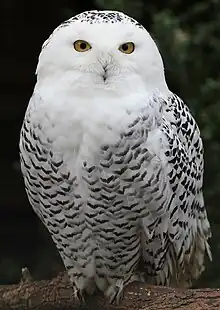| Afroaves Temporal range: Paleocene to present | |
|---|---|
 | |
| Snowy owl, Bubo scandiacus | |
| Scientific classification | |
| Domain: | Eukaryota |
| Kingdom: | Animalia |
| Phylum: | Chordata |
| Class: | Aves |
| Clade: | Telluraves |
| Clade: | Afroaves Ericson, 2012 |
| Subclades | |
Afroaves is a clade of birds, consisting of the kingfishers and kin (Coraciiformes), woodpeckers and kin (Piciformes), hornbills and kin (Bucerotiformes), trogons (Trogoniformes), cuckoo roller (Leptosomiformes), mousebirds (Coliiformes), owls (Strigiformes), raptors (Accipitriformes) and New World vultures (Cathartiformes).[1][2] The most basal clades are predatory, suggesting the last common ancestor of Afroaves was also a predatory bird.[2]
The following cladogram of Afroaves relationships is based on Jarvis et al (2014),[2] with some clade names after Yury, T. et al. (2013)[3] and Kimball et al. (2013).[4]
| Afroaves |
| |||||||||||||||||||||||||||||||||||||||||||||||||||||
Afroaves has not always been recovered as a monophyletic clade in subsequent studies. For instance, Prum et al. (2015) recovered the accipitrimorphs as the sister group to a clade (Eutelluraves) comprising the remaining afroavian orders and Australaves,[5] while an analysis by Houde et al. (2019) recovered a clade of accipitrimorphs and owls as sister to the remaining landbirds.[6]
| Jarvis et al. (2014)[2] | ||||||||||||||||||||||||
|---|---|---|---|---|---|---|---|---|---|---|---|---|---|---|---|---|---|---|---|---|---|---|---|---|
|
| Prum et al. (2015)[5] | ||||||||||||||||||||||||
|---|---|---|---|---|---|---|---|---|---|---|---|---|---|---|---|---|---|---|---|---|---|---|---|---|
|
| Houde et al (2019)[6] | |||||||||||||||||||||
|---|---|---|---|---|---|---|---|---|---|---|---|---|---|---|---|---|---|---|---|---|---|
|
References
- ↑ Ericson, P.G. (2012). "Evolution of terrestrial birds in three continents: biogeography and parallel radiations" (PDF). Journal of Biogeography. 39 (5): 813–824. Bibcode:2012JBiog..39..813E. doi:10.1111/j.1365-2699.2011.02650.x. S2CID 85599747.
- 1 2 3 4 Jarvis, E. D.; Mirarab, S.; Aberer, A. J.; Li, B.; Houde, P.; Li, C.; Ho, S. Y. W.; Faircloth, B. C.; Nabholz, B.; Howard, J. T.; Suh, A.; Weber, C. C.; Da Fonseca, R. R.; Li, J.; Zhang, F.; Li, H.; Zhou, L.; Narula, N.; Liu, L.; Ganapathy, G.; Boussau, B.; Bayzid, M. S.; Zavidovych, V.; Subramanian, S.; Gabaldon, T.; Capella-Gutierrez, S.; Huerta-Cepas, J.; Rekepalli, B.; Munch, K.; et al. (2014). "Whole-genome analyses resolve early branches in the tree of life of modern birds" (PDF). Science. 346 (6215): 1320–1331. Bibcode:2014Sci...346.1320J. doi:10.1126/science.1253451. hdl:10072/67425. PMC 4405904. PMID 25504713. Archived from the original (PDF) on 2015-02-24. Retrieved 2015-08-29.
- ↑ Yuri, T.; et al. (2013). "Parsimony and Model-Based Analyses of Indels in Avian Nuclear Genes Reveal Congruent and Incongruent Phylogenetic Signals". Biology. 2 (1): 419–444. doi:10.3390/biology2010419. PMC 4009869. PMID 24832669.
- ↑ Kimball, R.T. et al. (2013) Identifying localized biases in large datasets: A case study using the Avian Tree of Life. Mol Phylogenet Evol. doi:10.1016/j.ympev.2013.05.029
- 1 2 Prum, R.O. et al. (2015) A comprehensive phylogeny of birds (Aves) using targeted next-generation DNA sequencing. Nature 526, 569–573.
- 1 2 Houde, Peter; Braun, Edward L.; Narula, Nitish; Minjares, Uriel; Mirarab, Siavash (2019). "Phylogenetic Signal of Indels and the Neoavian Radiation". Diversity. 11 (7): 108. doi:10.3390/d11070108. ISSN 1424-2818.



